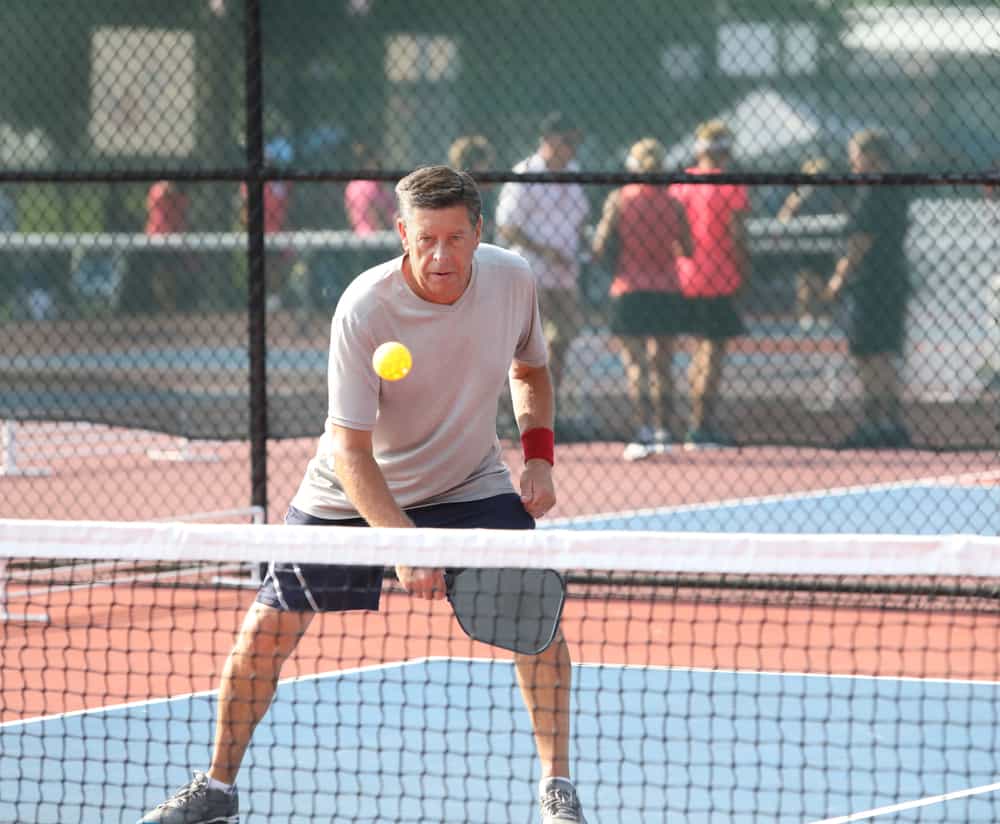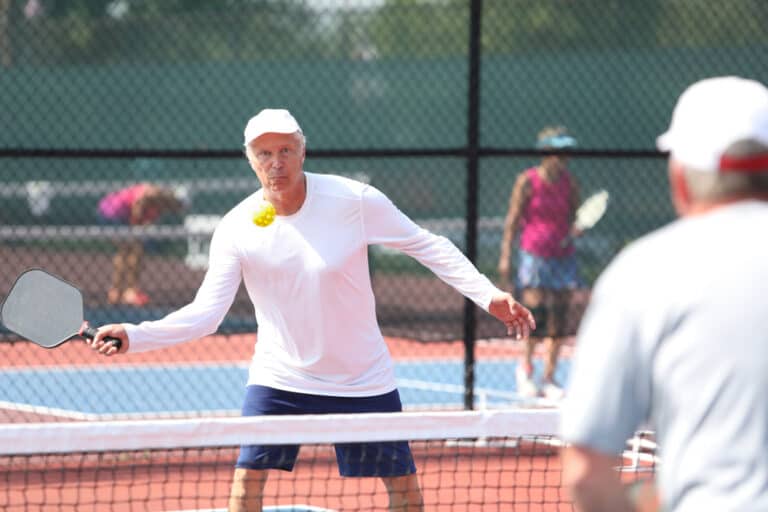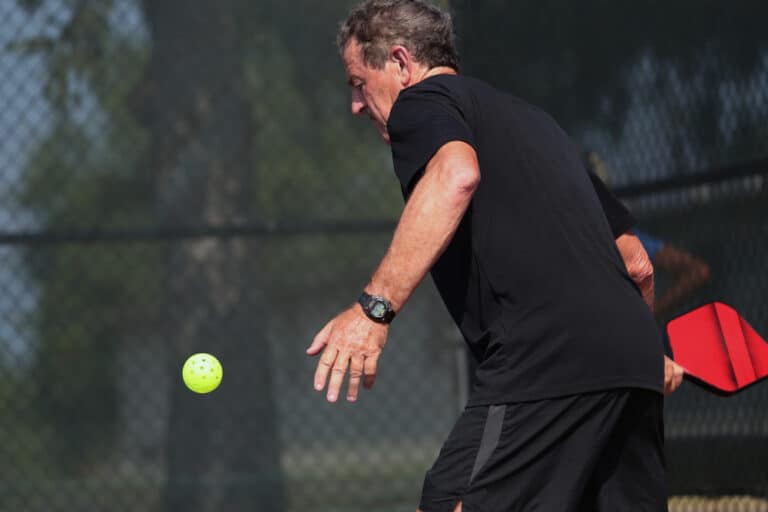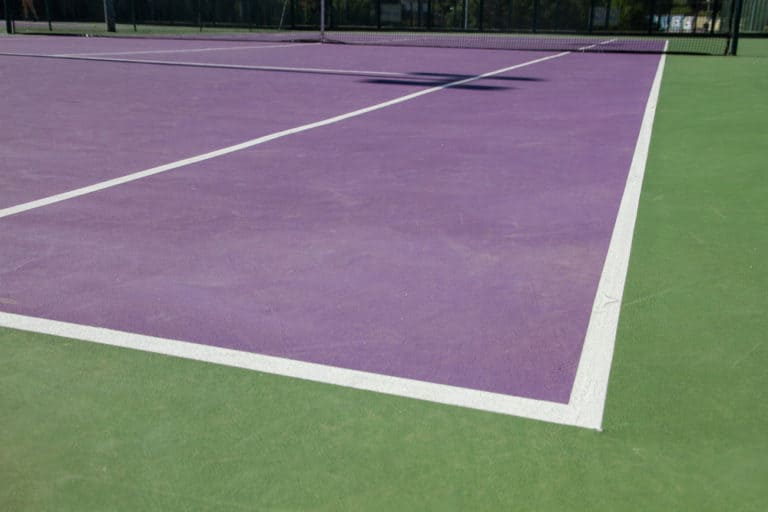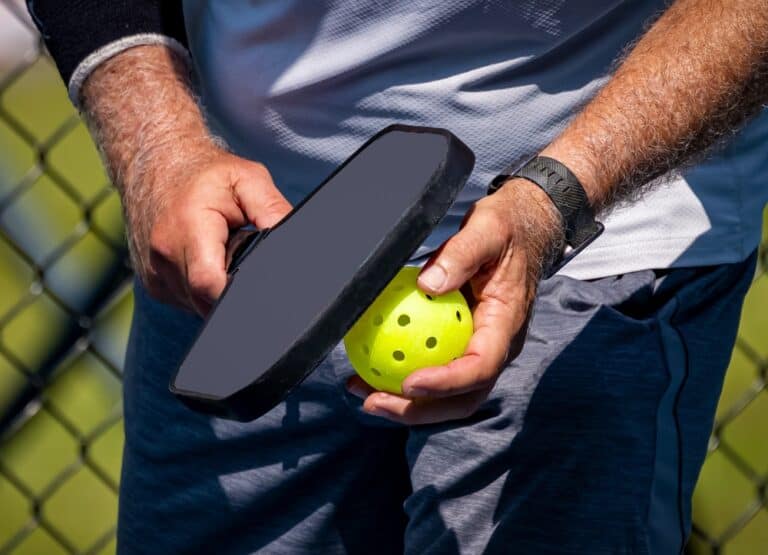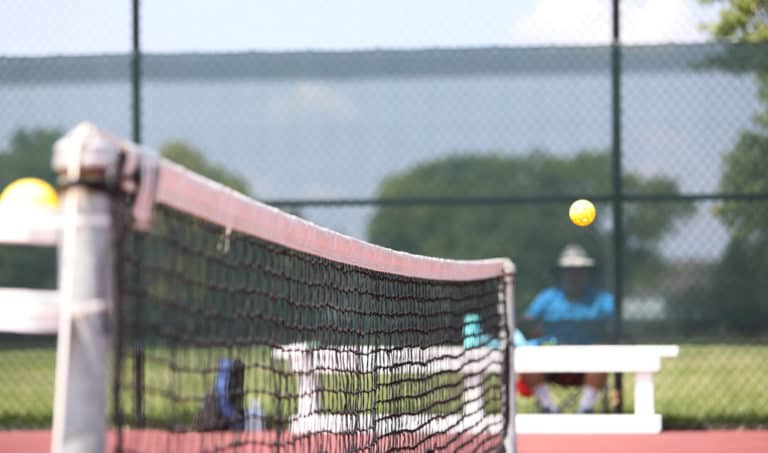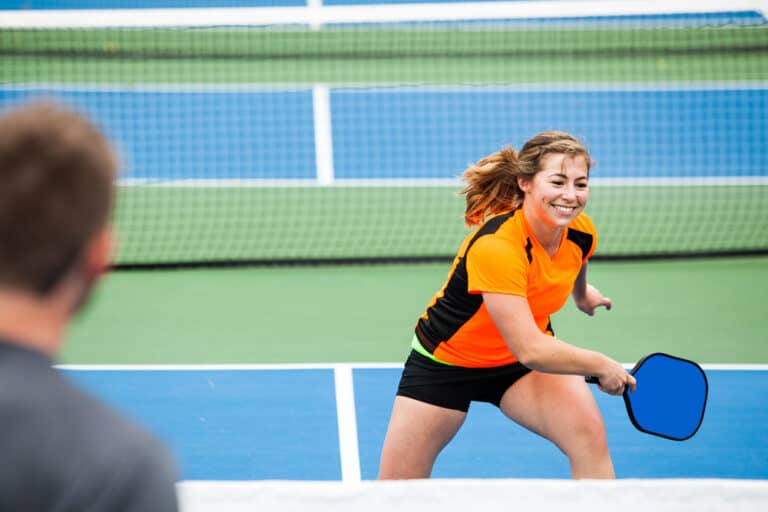What Is A Nasty Nelson In Pickleball?
The beloved American game of Pickleball is endlessly enthralling and intricate. There are many playing styles and trick shots that you can add to your itinerary, so you might have heard of ‘A Nasty Nelson’ and wonder what type of shot that is.
In Pickleball, a Nasty Nelson is an intentional trick serve that entails a player hitting the ball directly onto the opposing player’s body, resulting in a fault since the ball did not bounce first. It is named after Pickleball player Tim Nelson and is considered a controversial shot.
Timothy Nelson, better known as Tim ‘The Puppet Master’ Nelson, has stirred opinions on whether the Nasty Nelson is appropriate in Pickleball. We will tell you more about the theory of a Nasty Nelson, tell you what Pickleball players have to say about the shot, and other serving styles you can add to your Pickleball game instead of a Nasty Nelson.
Theory Of A Nasty Nelson In Pickleball
Performing a Nasty Nelson is a simple way to cause a fault but is also thought to show poor sportsmanship. The Pickleball rules created a loophole for a Nasty Nelson to be a legal, conversation-starting trick shot.
Pickleball receiver fault rules state that if the ball is served and hits the body of a receiving player before bouncing, it results in a fault on the receiving team, or if you’re playing Pickleball Singles, the receiving player. This rule was initially in place to govern obstructing the ball with your body and interrupting gameplay but has since been used as a tactic to win a fault grown to be known as, you guessed it, a Nasty Nelson!
Serving in Pickleball can heavily influence the outcome of your game, and out of the many styles, the Nasty Nelson has sprouted on many unsuspecting players. This serving style is usually taken advantage of if an opposing team player appears to be unfocused or blocks the game. The Nasty Nelson can be served to any receiving team player, no matter where they are on the court.
Tim ‘The Puppet Master’ Nelson got his name by mimicking a puppeteer after performing good shots, like the Nasty Nelson, and he was the one to make a Nasty Nelson the intentional trick shot it is and made it famous. The Pickleball community is in two minds on whether the Nasty Nelson is acceptable, and although it is legal in the game, it has proven to be distasteful.
Tim Nelson has performed a Nasty Nelson many times throughout his career. He is a talented player, and the Nasty Nelson requires agility and great aim. He is the main reason the Nasty Nelson has a reputation since Tim is arrogant and has even seen to hit the ball hard, straight into someone’s face, which almost everyone would say is poor sportsmanship.
What The Pickleball Community Has To Say About The Nasty Nelson
Since there are many Pickleball players and fans alike, there is a divide in opinions. The Nasty Nelson is seen either as a shot that holds merit or one that is obnoxious and unnecessary.
Since the source of the Nasty Nelson is Tim ‘The Puppet Master’ Nelson, his personality shaped opinions on this move. Ultimately it is called a Nasty Nelson, and Tim’s nickname follows his patronizing puppeteer movements after actioning a good shot against his opponents.
Tim Nelson goes out of his way to distract players so that he can use his Nasty Nelson weapon. He has sworn on the court, trying to assert dominance, but luckily profanity has since been banned by Pickleball rules, which results in a lost point or verbal warning. He also has been said to be a bad teammate and take ownership of the court without sharing the glory of a good game.
A Nasty Nelson was initially accidental, so it might not always be adverse to use reasonable loopholes, especially if you want to play Pickleball as a mental game. If your opponent blocks your serve, it can be annoying, so some might see a Nasty Nelson as a functional tactic against this. A Nasty Nelson might even help you win a game, and all is fair in love and war, especially when the move is legal.
Some of the Pickleball community defend’ The Puppet Master’ by saying that his controversy makes for a riveting game worth talking about and prevents competitions from being stale. They might agree that his personality is not one of a great sportsman, but it adds flair to the entertainment aspect of Pickleball.
There is a consensus that a Nasty Nelson is disrespectful, especially in a tournament. Although the move is not particularly tournament-friendly, it would be most appropriate to serve a Nasty Nelson in a friendly game between friends for goodhearted fun.
If you’re seeking new moves to try out in a game of Pickleball, the Nasty Nelson should not be at the top of the list due to its debate and negative sportsmanship status. There are many serving styles in Pickleball to choose from, and it would be best to keep a Nasty Nelson between friends.
How To Serve A Nasty Nelson
If you want to add a Nasty Nelson to your gameplay, it’s a perfectly legal move and will bring a shock factor. Ensure that the atmosphere is right before performing a Nasty Nelson, as you don’t want to seem disrespectful.
Pickleball serving rules outline that in a standard serve, you may not hold the paddle in such a way that the head is above your wrist, the paddle may not raise above your naval before the serve and not move in a downward motion, but if the ball bounces before you serve, these rules need not apply. A Nasty Nelson is permitted if your serve abides by these Pickleball rules as it is fully allowed.
You must be on the serving team to execute a Nasty Nelson by hitting the ball onto the receiver’s body before they have time to react and return the serve. It would be best to shoot a Nasty Nelson when your opponent seems distracted, for example, if they are looking away or talking to their teammate. There are no rules against an intentional distraction, but it is considered poor sportsmanship.
During the Nasty Nelson, the ball should travel through the air and may not touch the ground or net before it contacts the receiver. Try not to slam the ball too hard, or you could end up hurting your opponent, and no one wants to cause harm, and Tim Nelson was wrong for doing that! Although you can serve a Nasty Nelson on a player further back, you would be more successful if you hit the team member closest to the net.
Your best chance for a successful Nasty Nelson is if your opponent is close to the centerline as the angle is easier to aim for and more appropriate since the team member nearest to the net is causing a block to the proper service court. If you succeed at a Nasty Nelson as the server, it results in a Receiver Fault, and you will win the point.
If you’re on the receiving team and don’t want to be a Nasty Nelson target, we advise you to remain focused throughout the game and avoid blocking the centerline. Avoid turning around and looking at your partner, but if you get hit with one, even by accident, feel free to laugh it off!
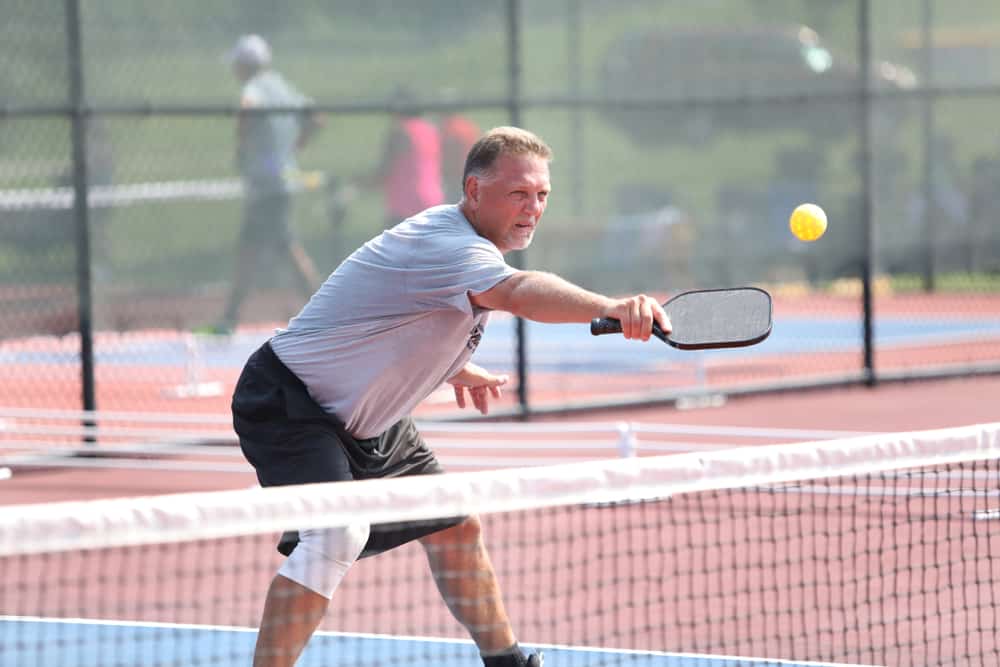
Other Serving Styles Instead of A Nasty Nelson
Since the Nasty Nelson is not the best serving option due to its poor sportsmanship status, you might still want to add some new moves to your game of Pickleball, and luckily there are a number of alternatives at your disposal. The Nasty Nelson brings the element of surprise, but so can any good pre-calculated serve!
Centerline Serve
A serve down the centerline should catch your opponent off-guard. The Centerline Serve must start on or close to the center and aim for the center. If you veer too much to one side, it complicates your aim to the center but if you feel you have the aiming skills for being off center and can target down the centerline, it helps creates an element of surprise. You don’t need to mess with your serving style much since a Centerline serve is mainly about where you direct the ball.
Kitchen Corner Serve
The Kitchen Corner Serve brings the receiver out to the sidelines to create a gap in the center in preparation for your third shot since your serve should always bring about a bad return for your opposition. Position yourself on the opposite corner of the court from your target side and serve quickly. Your body language should stay casual and not be clear that you’re heading to the court’s sideline.
Power Serve
A power serve creates a powerful hit with topspin, sure to surprise the receiving team. You can position yourself anywhere behind the baseline but take a step back before you start, and when you hit the ball, you want to shift your weight towards the ball. Lag your paddle for a distance before snapping the paddle onto the ball in a smooth non-wrist motion. The hit from your paddle should act like a whip to unleash the maximum power.
High Soft Serve
The High Soft Serve adds variety to your serving itinerary because it shoots the ball softly to the opponents, and they must create their ball speed and power instead of blocking, which adds an element of surprise. Also known as a Lob Serve, a High Soft Serve is a high arcing shot that you start by hitting the ball from underneath up toward the sky at a level pressure, not hard, and you can also try to add some topspin to make it more advanced. High Soft Serve is a favorite for beginners and professionals alike!
Power Lob Serve
This mixture between a Power Serve and High Soft Serve is unique and potent with a lower arc than a High Soft Serve, but due to your increase in serving power, it still reaches the opponent’s baseline and makes it difficult for them to return. You want to start the shot low and sweep it high, hit from beneath, create topspin and come into the serve with force. Lean upwards as you take the serve, keep your wrist stable, and sweep as you would in the power shot; and to ensure you keep to the correct motion, move the paddle up to your opposite ear after hitting the ball.
Drop Serve
The 2021 Pickleball rule update made Pickleball a whole new ball game by forfeiting the need for the paddle to be below the wrist and naval while serving and the necessity for an upward swing IF you let the ball bounce before you take the serve. These rule changes allowed for new serving inventions, and to Drop Serve is to drop the ball without any force, as it would be illegal to force it, then hit the ball with force by curving your paddle from high to low. You can try many variations of the Drop Serve due to the rule freedom, allowing this serving style to be the most beginner friendly.
Conclusion
The Nasty Nelson was made famous by Tim ‘The Puppet Master’ Nelson and named after his teasing antics! The Nasty Nelson hits a receiving player in the air before they have a chance to react and is more appropriate to execute if they are unfocused or blocking the centerline. You can perform a Nasty Nelson yourself, but you should reserve it for a game between friends rather than in a tournament.
Since a Nasty Nelson can seem like a serve of poor taste, there are many other serving styles you can try out, such as a Centerline Serve, Kitchen Corner Serve, Power Serve, High Soft Serve, Power Lob Serve, or even the newer Drop Serve! If you are to try a Nasty Nelson, be careful not to hurt your opponent, but on the other hand, it’s a legal serving style and can give your friends a laugh!
References
- https://www.youtube.com/watch?v=wysulucOCQQ
- https://www.youtube.com/watch?v=mUDvl40lq2s
- https://www.youtube.com/watch?v=aFH2rfoa2LM
- https://www.reddit.com/r/Pickleball/comments/t15wom/nasty_nelson_in_a_tournament_fair_or_foul/
- https://www.reddit.com/r/Pickleball/comments/kvxn3i/when_serving_hitting_the_other_opponent_whose/
- https://www.reddit.com/r/Pickleball/comments/mvndyc/nasty_nelson/
- https://www.reddit.com/r/Pickleball/comments/42nyiu/ive_been_on_the_fence_about_posting_this_vid/
- https://www.youtube.com/watch?v=zKXcarmLAZo&t=20s
- https://en.wikipedia.org/wiki/Glossary_of_pickleball_terms
- https://www.youtube.com/watch?v=T02xOTLRpvo
- https://www.youtube.com/watch?v=_lgkeru0nwg
- https://www.youtube.com/watch?v=9CRoacLovDI
- https://www.youtube.com/watch?v=nW0l0zzRwlU
- https://www.youtube.com/watch?v=Zwl_mF1Oims&t=53s
- https://www.youtube.com/watch?v=N43DwVEZoqk
- https://www.youtube.com/watch?v=wysulucOCQQ&t=6s

